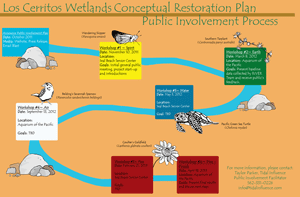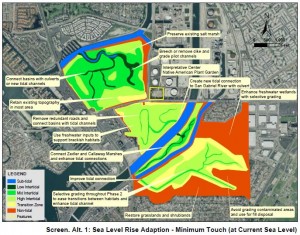Public Involvement for the
Conceptual Restoration Plan
RIVER Trail – Roadmap (PDF)
Workshop#1
View more PowerPoint from TidalInfluence
Workshop #1 Summary:The first public workshop was held at the Seal Beach Senior Center on November 10th 2011 and had 75 participants from the general public. As part of the workshop, a feedback activity was conducted to understand how the participant’s value the Los Cerritos Wetlands. A survey was distributed along with a map for the workshop members to write on and express their values and concerns of the wetlands. 40 surveys were returned and you can see the results of that feedback activity on the PDF below.
Workshop #1 Activity Results(PDF)
Workshop#2
LCW Conceptual Restoration Workshop #2
View more PowerPoint from TidalInlfluence
Workshop #2 Summary: The second public workshop was held at the Aquarium of the Pacific on March 8th, 2012 and had 61 participants from the general public. As part of the workshop, a feedback activity on the baseline data of the habitats, watershed and hydrology, the public access, this website, and the opportunities and constraints was conducted in the Aquarium’s Watershed Classroom. A survey was distributed along with Post-It notes and markers. Then, we encouraged participants to walk around to each of the stations and discuss with the experts at each station the data they were presenting. You can see the results of that feedback activity on the PDF below as well as the photos in the slideshow, also below.
Workshop #2 Activity Results (PDF)
Workshop#3
View more PowerPoint from TidalInlfluence
Workshop #3 Summary: The third public workshop was held at the Seal Beach Senior Center on May 10th, 2012 and had 35 participants from the general public. As part of the workshop, a feedback activity to initiate the discussion and development of Conceptual Restoration Alternative Designs began. Opening up the discussion of the Alternative Design with the Public began the discussion of Alternatives for the entire process. We encouraged participants to draw on the provided maps in red, blue and green markers to indicate their preference for no change, little change or maximum change. While the information gathered from the public through the workshop and through individual communications is highly valuable, the LCWA and the consulting team consistently remind everyone that this design process is a complex one. Even though participants may present a great idea, those ideas may not be in the final designs. During this process we are treating all ideas as great data points to consider in perspective with all others. You can see the results of that feedback activity on the PDF below as well as the photos in the slideshow, also below.
Workshop #3 Activity Results ( PDF )
Workshop#4
LCW Conceptual Restoration Workshop #4
LCW Conceptual Restoration Workshop #4 from TidalInlfluence
Workshop #4 Summary:The fourth public workshop was held at the Aquarium of Pacific on September 20th, 2012 and had 40 participants from the general public. As part of the workshop, a feedback activity to review the initial screening alternatives of the Conceptual Restoration Alternative Designs began. “Screening Alternatives” is an interesting term that may need some explaining. Instead of developing initial ideas of what could end up as a reality on-site, what we attempted to do was see the extremes of what is possible if we did the minimum amount necessary to meet the goals and objectives of the conceptual restoration process and what it would look like if we did the absolute maximum. Additionally, we then grouped our minimum and maximum touches into ‘themes’ to direct our thought process. Our themes are: Habitat Diversity, Connectivity and Sea Level Rise. We understand that each of these will be critical in all analysis of the project site but in this exercise these themes are the ‘goggles’ we are putting on so as to only focus on the results that are produced. The results of each theme will then encourage a discussion of what those specific results show.
We want people (the general public, the Technical Advisory Committee, community groups, etc) to look at the screening alternatives and provide comments on what, if any, restoration measures, they like and don’t like. In addition, we want people to let us know if there is anything we missed in terms of restoration measures. It is our hope that we will come out of the screening alternatives process with a full range of restoration measures that we will use to craft the final alternatives. For example, no one has yet commented that we should include restoration of an area (or the entire site) to a subtidal basin. If we get through this process and no one provides such input then we feel we do not have to consider such a measure in the final alternatives.
Consequently, we are not looking at having people provide comments on the themes because the themes will ultimately be dropped in order to arrive at the final alternatives – they are just another tool to get us where we are going.
These Screening Alternatives were developed collectively to capture all the goals and objectives to get everything “on the table” for consideration. Our plan is for this process to end with three alternatives that capture the range of restoration measures with one at each end of possibilities and one somewhere in between.
We encouraged participants to review the six alternatives following the various themes and provide feedback that would focus on what we called the ‘highlights’ and the ‘lowlights’ or components that participants found favorable and those not particularly so. Because we want to give adequate time for review of these screening alternatives, we have posted a link to the Screening Alternatives, narratives explaining each alternative and the feedback form to receive comments on each alternative.
While the information gathered from the public through the workshop and through individual communications is highly valuable, the LCWA and the consulting team consistently remind everyone that this design process is a complex one. Even though participants may present a great idea, those ideas may not be in the final designs. During this process we are treating all ideas as great data points to consider in perspective with all others. You will be able to see the results of the feedback activity when they are all submitted. You can also view the photos from the workshop below.
We encourage review of the screening alternatives and ask that you click on the link below to see them. Also, if you would like to provide feedback, please email your responses to: info@tidalinfluence.com.
Screening Alternatives ( PDF )
(PDF)
Workshop#5
LCW Conceptual Restoration Workshop #5
Workshop #5 Summary:The fifth public workshop was held at the Aquarium of Pacific on April 18th, 2013 and had approximately 30 participants from the general public. As part of the workshop, a feedback activity to review the 3 Conceptual Restoration Alternatives was held. Please, review the alternatives – hyperlinked below- and send in your feedback to help us with your analysis report. Please send in your comments by May 15th, 2013 to taylor@tidalinfluence.com
Workshop#6
LCW Conceptual Restoration Workshop #6


